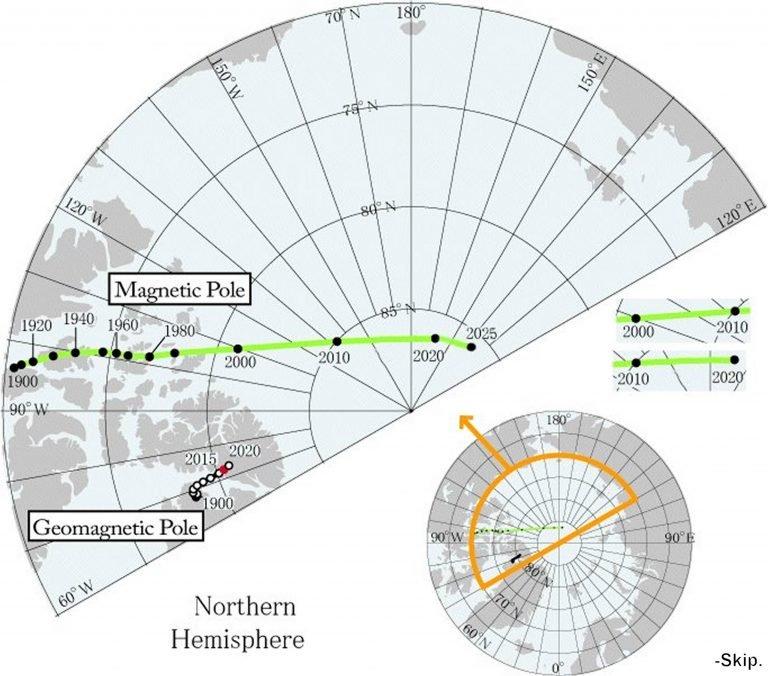Earth’s Magnetic North Pole Is Moving Faster Than Ever, Leaving Scientists Baffled
Authored by Elias Marat via TheMindUnleashed.com,
Earth’s magnetic north pole is moving at unprecedented speeds and scientists are still unsure of why this is the case.
What makes these recent changes so interesting is the sheer speed at which they are occurring.
Some fear that the rapid movement of the magnetic north pole could cause problems for Global Positioning Systems (GPS), military operations, airliners, and other navigation systems that rely on pinpointing where precisely the pole is located.
Migratory animals such as birds, butterflies, and whales also use the magnetic field for directions.
The latest report from NOAA, the “World Magnetic Model” for 2020, shows the pole rapidly speeding in the direction of Siberia. However, the trajectory of the pole will likely change.
NGA in partnership with @NOAA and the @BritGeoSurvey, has released the World Magnetic Model 2020 update, providing more precise navigational data for all military and civilian planes, ships, submarines and GPS units. pic.twitter.com/VGyfui42MB
— NGA (@NGA_GEOINT) December 17, 2019
This isn’t the first time that this has happened—polar wandering has been constant since the North Pole was first discovered, according to the National Oceanic and Atmospheric Administration (NOAA).
NOAA’s National Centres for Environmental Information explained:
“Since its first formal discovery in 1831, the north magnetic pole has travelled around 1,400 miles (2,250 km).
This wandering has been generally quite slow, allowing scientists to keep track of its position fairly easily.”
As recently as 2000, the magnetic North Pole was clocked at moving 6.2 miles per year toward Northern Russia, but data for the next two decades shows the average rate suddenly increasing to roughly 34 miles per year in the same direction, while the latest readings in 2019 show it slightly decreasing to about 31 miles per year.
The World Magnetic Model predicts the average speed will slow down to roughly 25 miles per year from 2020 to 2025.
“The WMM2020 forecasts that the northern magnetic pole will continue drifting toward Russia, although at a slowly decreasing speed—down to about 40 km per year compared to the average speed of 55 km over the past twenty years.”
For the first time in recorded history, the pole has even passed by the Greenwich meridian—the imaginary line used to indicate 0° longitude and determine time zones.
Geomagnetic specialist Ciaran Beggan from the British Geological Survey (BGS) told the Financial Times:
“The movement since the 1990s is much faster than at any time for at least four centuries.
We really don’t know much about the changes in the core that’s driving it.”
The team of researchers that maintain the World Magnetic Model has updated it and released it a year ahead of schedule. The newly updated model shows the magnetic north pole moving away from Canada and toward Siberia https://t.co/nUzvCLmwsb pic.twitter.com/wZn2YXxekt
— Massimo (@Rainmaker1973) December 18, 2019
The new model also confirms that Earth’s magnetic field is weakening. If this continues, scientists say the field could collapse entirely and flip polarity—changing magnetic north to south and vice versa—and the consequences could be dire for the planet.
But before we begin to panic, we should remember that the Earth’s magnetic poles have already flipped up to 100 times in the past 20 million years, the last reversal occurring roughly 773,000 years ago.
Earlier this year, the rapid movement of the North Pole garnered headlines when scientists revealed that the north was moving so fast that they had to update their model of the planet’s magnetic field much earlier than expected.
At the time, the Mind Unleashed reported:
“The drift is the result of processes deep in the center of the planet, where the liquid outer core comprised of iron and nickel spins and flows like water, serving as a conductor for Earth’s magnetic field.
The recent change in the flow of the fluid is believed to be similar to the formation of a jet stream in the atmosphere, leading to changes in the planet’s magnetic field.
… these changes are all part and parcel of the natural behavior of the Earth and have not been caused by human activity. Rock samples reveal that the Earth’s magnetic field has been in perpetual motion for millions of years.”
University of Wisconsin-Madison geologist and NOAA study author Brad Singer told CNN that while the shifts in the pole could, in the long term, lead to impacts on satellites, communication, and navigation, researchers will likely have generations to deal with any major instability in the magnetic field.
“The decrease in geomagnetic field is much more important and dramatic than the reversal,” said Dr. Nicolas Thouveny from the European Centre for Research and Teaching of Environmental Geosciences (CEREGE) in Aix-en-Provence, France.
“It is very important to understand if the present field will decay to zero in the next century, because we will have to prepare.”
Tyler Durden
Thu, 12/19/2019 – 22:45
via ZeroHedge News https://ift.tt/2EA3wMh Tyler Durden
